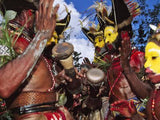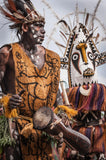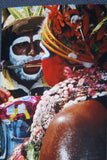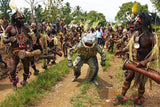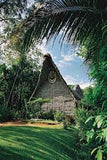Old Unique Sing-Sing Festival Ceremonial Hand Carved Wood Bowl, Large Platter to serve Betel, Lime, Sago & Grub during Initiations, Rites of passage, Wars victories, Weddings, 22" Long, Ramu River, Papua New Guinea. Item 60A17. Mid to Late 20th C.
New Guinea Art.
ITEM: 60A17.
RARE COLLECTIBLE.
VERY RARE AND OLD LARGE VINTAGE HAND CRAFTED PLATTER.
This is a long oval hand carved older wood burnished feasting ceremonial bowl with Ramu carvings on the handles (typical stylized crocodiles morphing into penises), from the Lower Ramu River of Papua New Guinea. These huge ornamental bowls were reserved for special occasions. Not only was this style bowl used during village celebrations, but it was an essential part of the traditional bride price.
Oceanic Art. Mid to Late 20thCentury
This old Oceanic Art Ceremonial Wooden Food Platter was once used to serve treats such as “betel and lime habit ingredients”, or food such as sago, grub worm and pudding known as Pollom and Yams, during special festivities and celebrations such as initiations, coming of age, bride price, war victories etc...
The shape is copied from that of a canoe, embodying the notions of both container and vehicle. This metaphor is common; New Guinea people also may refer to the body as a canoe for the soul or spirit.
The design on each handle here is a traditional Ramu River motif, usually stylized crocodiles with hints of manhood.
The platter was used and it is solid.
In great condition for an old and used dish and a great value. Amazingly beautiful considering the basic tools available on the premises. It is very hard to come across such collectibles unless you go there
From the Ramu River, Papua New Guinea
Measures: 22" X 8 3/4" X 4"
Always look at photos carefully to be satisfied, pictures speak louder than words.
Food Serving bowls, such as this one, are also very important items of use and trade: and one way for different tribes to copy motifs of decoration distributed throughout the region through such trade, yet the designs usually are owned and cannot be copied promiscuously without consequences, in each region. They commemorate some event or memory of the carver and the interpretation must be obtained from the carver himself. Sometimes designs are given as gifts to trading partners or are inherited.
The wooden bowls from the Lower Sepik region, for instance, probably were received as gifts from trading partners or in trade from the Ramu, lower river villages, or one of the offshore islands. Food bowls for both daily and ceremonial use often are decorated with designs representing objects (animals) with female associations &, or, on the lugs or handles with male motifs, as seen here. These objects represent the domestic power of women to nurture, as well as the power of men to dominate through feasting and war.
Every item of use, in daily life or war, is always symbolic thus carved with motifs meant to protect the owner from spirits lurking in the woods, and the tribe must be protected from such evil with carvings that repel them.
Such pieces are used by the indigenous people of the most primitive areas of Papua New Guinea. These proud people have managed, in the face of continued government and missionary pressure, to maintain a culture of incredible depth and beauty. For the most part, they still live by the same methods as have existed in their remote land for thousands of years.
I HAVE SEEN SIMILAR ELSEWHERE FOR $600.00.
All our collector and rare items come with pages and pages of research about provenance, and with history of the tribes and photos as well, depending on item and whenever possible. When shipping internationally, we group ship multiple purchases to save you money, and find the best rates available. If you have any questions or want to see research conducted on this piece and photos of tribes, let us know.




































